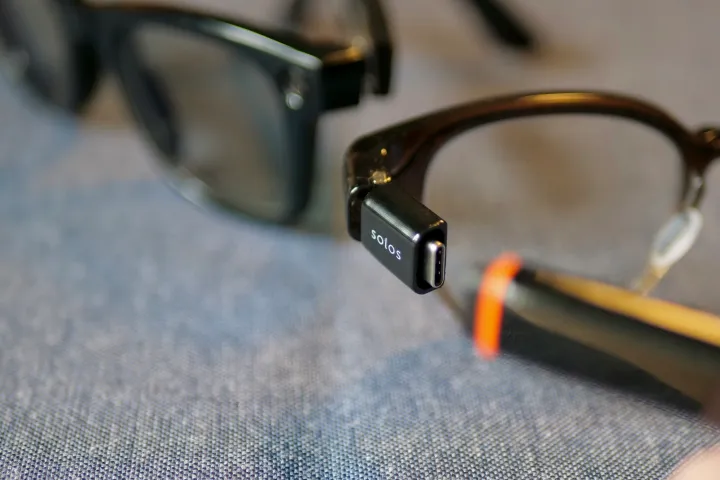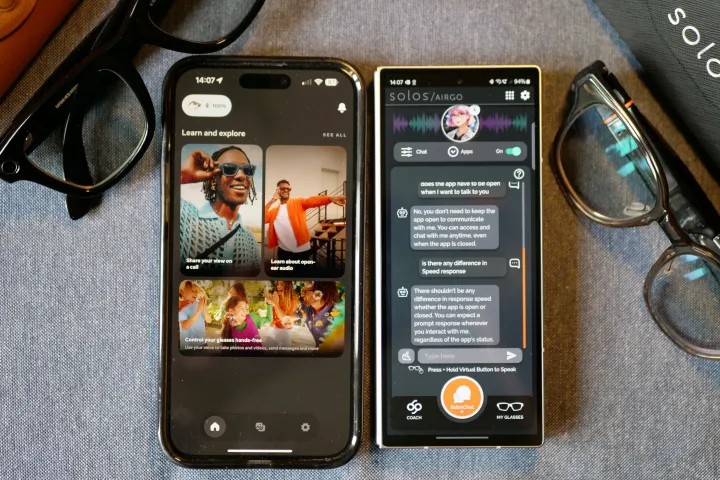The Ray-Ban Meta smart glasses are not your only choice if you want some wearable tech for your face. I’ve been trying the Solos AirGo 3, which differ from the Ray-Ban Meta in several ways, but are just as compelling if you want to ride this wave of new connected technology.
If you’re undecided between the two, here’s an in-depth guide from someone who has worn both to help you make a decision.
How much do they cost?

The Ray-Ban Meta smart glasses start at $299, but depending on the style, the size of the frame, and the type of lens you choose, this price can increase to $379 or more — particularly if you decide on the Transitions lenses. These change the level of tint depending on the amount of sunlight and are useful if you intend to wear the smart glasses indoors and out.
I’ve been wearing the Solos AirGo 3 Argon 6S smart glasses, but other shapes, colors, and sizes are available — including models designed to be sunglasses only. The AirGo 3 start at $249, with the price rising to at least $299 depending on the design and lens type you choose. You can also select lenses that react to sunlight, which Solos calls Photochromic.
How do they feel on your face?

For reference, I’ve been wearing the Shiny Black Ray-Ban Meta smart glasses and the AirGo 3 Argon 6S model in Blaze Brown from Solos. Because the Ray-Ban Meta are based on the familiar Wayfarer design, I had a good idea of whether they would suit my face or not and didn’t really need to try them on ahead of time. The size and shape is close enough to the non-smart Wayfarer that I felt confident selecting them.
It’s different with the AirGo 3, as they are a custom design from Solos, but the website does provide some handy measuring tips to ensure you get the right size for your face. You’ve still got to be careful in selecting the design, though, as not all shapes will suit you, even if you like the look, and that’s especially true if you plan to use them with clear lenses. I measured my face using Solos’s guidance and chose the Argon 6S model, and am pleased with the shape and design.

There is a big difference between “feel,” though, and while I’m going to explain, remember this is my personal experience, and it may be different for you. I can wear the Ray-Ban Meta for many hours, but I do eventually notice the additional weight of the glasses on the bridge of my nose. It’s not painful, just noticeable, and the fatigue can become annoying. Fortunately , the grip from the arms and the integrated nose pads is exactly right, and they don’t slip around at all.
The AirGo 3 have more traditional nose pads that can be bent into shape to help the smart glasses better fit your face, and they are the worst part of the overall design. It takes a while to get them right and they do dig in when the fit is wrong.
It’s worth the effort to get them right as the AirGo 3 are lighter than the Ray-Ban Meta — 37 grams compared to the Meta’s 50 grams with my prescription — and I can wear them for longer without fatigue. However, the thin tips on the end of the arms provide less grip than I’d like, leaving the weight on my nose. However, they are closer to non-smart glasses in terms of wear than the Ray-Ban Meta.

Neither are as comfortable to wear for very long periods as my non-smart spectacles are and, as I have to wear glasses all the time, I wouldn’t want either to be my only pair of glasses. The AirGo 3’s light weight does mean I can wear them for longer periods without fatigue, but as we’ll come to next, the Ray-Ban Meta’s lenses are my preference. Both pairs provide a good level of comfort, and all-day wear is possible, but I always choose my regular spectacles for relaxation and evening wear.
Can you get prescription lenses?

Both pairs of smart glasses are available to purchase with prescription lenses, and the price will vary depending on your specific requirements. You can select lenses that adapt to lighting conditions, too, and I have this option in each pair. My own optician ordered and fitted the lenses to the Ray-Ban Meta glasses, and they used the same company as Ray-Ban would have done if I had ordered through the website.
Solos offers its own service, and this is how the glasses were delivered to me. It’s worth noting that my first review pair only had one lens with my prescription, but the company then sent out a replacement pair that was correct. Solos only offers single-vision lenses, while Ray-Ban will provide varifocals depending on your prescription. This does make a big difference to everyday wear, and you absolutely will notice the difference if you need varifocals, but opt for single-vision lenses from Solos anyway.

I have the Transitions lenses in the Ray-Ban Meta and the Photochromic lenses in the Solos AirGo 3. Both react well to sunlight, and I have noticed the AirGo 3 lenses get darker than the Ray-Ban Meta, but the Ray-Ban lenses react to smaller changes in lighting conditions. I also find the Ray-Ban lenses provide a higher-quality, sharper level of vision. They were expensive, but it does make a difference.
I generally prefer the lenses fitted to the Ray-Ban Meta. Being able to get varifocals is a huge benefit, I like the subtlety of the transition between clear and dark, plus the lenses have a clarity and sharpness that matches the Zeiss lenses in my non-smart spectacles. The AirGo 3 prescription lenses do the job, but the lower cost is obvious to me when I look through them.
How does the hardware compare?

Wearing a device on your body is very different from carrying one around in your hand, and smart glasses hardware is arguably even more important than smartwatch hardware, and up there with smart rings in terms of an essential need to balance style, design, and fit with functionality. For me, the Ray-Ban Meta wins this category, with the caveat that you are paying more for them in the first place, and they are coming from a brand with huge experience in making spectacles of all types.
The injected plastic Ray-Ban frames are far more substantial, with very little flex, smooth hinge action, and a compact shape when folded up. The Ray-Ban logo on the arms has the right amount of credibility and style, while the metal parts feel tough and long-lasting. The hardware has an IPX4 water resistance rating, so they are fine in the rain, but not in the pool and not in dusty environments either. They sit inside a specially designed, hard-shell case with a built-in battery to charge the glasses when not in use.

The Solos AirGo 3’s case doesn’t have a battery inside, but this allows it to fold flat when not in use, so it’s more convenient to carry around, yet it’s still solid enough to provide protection when it’s unfolded with your glasses inside. The Solos also earned an IP67 water and dust resistance rating, which is impressive given that the arms can be separated from the frame. This unusual feature means you can purchase different frames without having to buy the entire kit, potentially saving money and effort setting up and pairing multiple different glasses.
However, the hardware itself is less impressive than on the Ray-Ban Meta. There’s considerable flex in the acetate frame, the hinges are plastic, and you can see the wire set in the top of the frame. Plus, the arms are shaped oddly. I don’t like the orange flash on the arms or the way the arms move around where they connect to the frame. They feel cheap compared to the expensive-feeling Ray-Ban Meta. It’s great to see so many frame designs available from Solos, but it’s always going to be competing with a bona fide style icon, and that makes its job much harder.
What about the controls?

Both pairs of smart glasses have touch controls in the arms, while the AirGo 3 also has a press-to-talk virtual button that acts as a power control. The Ray-Ban Meta has a physical slider on the inside of the arm to turn the glasses on and off. The AirGo 3’s touch panel allows you to adjust the volume with a swipe, but it’s not very accurate, and I find myself swiping multiple times before it recognizes my touch.
It’s the same problem with the virtual button, which seems to turn the glasses on without a problem, but almost never recognizes the longer press required to turn them off again. The times when it does recognize the input are when you are talking to the AI, which is very annoying. Several times, I’ve managed to turn the volume right down, and have been unable to raise it again for a while. The whole system reminds me of true wireless earbud touch controls from a few years ago, when they just weren’t quite ready for mainstream use.

The Ray-Ban Meta’s controls feel light-years ahead in terms of responsiveness and accuracy. I love the hardware switch to turn the glasses on and off and use it often. It’s helpful to conserve battery life and also for situations where I want to stop my phone from prioritizing the glasses for audio, such as when I am in my car. The camera — a feature not shared by the AirGo 3 — also has a physical shutter button. It’s a far more intuitive and faster to use system on the Ray-Ban Meta smart glasses.
What makes the Ray-Ban Meta special?

Why should you buy the Ray-Ban Meta smart glasses? The big attraction is likely to be the camera, which is a huge amount of fun. You can also use the speakers in the glasses with your phone for calls and messages, plus you can do things like live stream to Instagram. Listening to audio is the other killer feature, and they are excellent when you want to ensure you can hear the world around you or don’t have a pair of headphones on hand.
You can also interact with Meta’s AI for voice and visual search, but only if you live in the U.S. and certain other regions where the feature is available. The AI feature is still not fully available to all owners in the U.K. The app is practically flawless, connecting to the glasses quickly when they are turned on and when images are transferred over and stored in the app and your phone’s gallery. It’s all neatly designed, and although it’s not feature-packed, it’s simple to find what you want.

I’ve used the Ray-Ban Meta connected to iOS and an iPhone 15 Pro Max and have not had any connection or syncing issues. The battery life is strong and will last a whole day, provided you have the always-listening voice activation switched off. With it on, expect four or five hours of battery life from a single charge. The smart glasses’ battery is topped up when it’s in the case, and I’ve never worried about the battery life in general or charged the case up much, either. They are very easy to live with.
There are several features I’d like to see, though, such as full notification support and more app compatibility, along with a wider release of the AI features. The Ray-Ban Meta are far from perfect, but they are very good at what they do.
What makes the Solos AirGo 3 special?

The Solos AirGo 3 do not have a camera, but their big feature is providing direct access to ChatGPT, which is ready to use for the usual productivity tasks and search queries. They also have a translate feature and a chat feature. Through the app, you can dictate messages to the glasses and send them via email or your messaging platform of choice. It’s somewhat successful, but also severely flawed.
While you can dictate messages to the glasses or give it an overview of what you want to say and let it generate a message, you must open the Solos app on your phone and manually send it, where you will find other problems such as emojis it generates appearing in WhatsApp only as question marks. When you ask ChatGPT questions, it responds in a time frame that’s dependent on your phone’s network. A transcript of your conversation can be found in the app. You can hear incoming messages read back to you through the speakers.

How helpful or interesting you find many of these features depends on how into ChatGPT and AI you are. I don’t really find many uses for instant access to AI, so once I’d tried it out a few times, I forgot all about it. It’s pointless dictating messages when you have to get your phone out to complete sending, and the touch controls on the frame are vague and irritating. It’s a similar situation with connecting the glasses to the phone, which is slower than on the Ray-Ban Meta, but at least the app is decently designed and it’s easy to find and use the features.
The battery easily lasts for a day, but there’s no always-listening mode, as you have to touch the virtual button to activate the glasses. Charging is performed using a proprietary cable or the USB-C connector hidden in the arm. There are a few other unusual features related to health, such as a posture tracker and some exercise plans with AI guidance. They are nice to see, but not everyone is going to find them useful. I do like the notification sounds, though, but there’s no indication of what app it’s alerting you about.
Listening to audio

Both pairs of smart glasses have speakers in the arms that play audio from your phone. You can take calls and hear messages read back to you, but the Ray-Ban Meta’s list of supported apps is restricted to the phone app, WhatsApp, Facebook Messenger, and Instagram. The AirGo 3 lets you choose from a much wider selection of apps that you can use with the glasses.
The AirGo 3 app has an equalizer feature and several custom audio style settings. The speakers have plenty of volume, but the world around you will hear everything that’s playing. Sound quality is fine for spoken word, but the bass is severely lacking, so music sounds tinny. The stereo effect is highly pronounced, but this aside, the entire audio experience is horribly low quality.

The Ray-Ban Meta’s audio performance is far superior. The speakers sound great, with more presence and bass, plus sharp vocals and a lovely, wide soundstage. I can happily listen to spoken word and music on the Ray-Ban Meta, and it’s never an uncomfortable listening experience. There’s a lot more sound isolation, too, so those around you won’t automatically hear everything that’s going on.
Which smart glasses should you buy?

If you’re choosing between the Ray-Ban Meta and the Solos AirGo 3, then the Ray-Ban Meta smart glasses are our recommendation. They are more refined as a piece of technology, have an iconic design that will likely suit most faces, and a range of styles and lenses that help you personalize them even further. The camera is a lot of fun, audio sounds great, and the AI a nice, if a bit niche, addition.
The AirGo 3 smart glasses are light and comfortable once you finish adjusting them, plus they pack a lot of features in, but many of them are held back by the poor controls on the glasses, as well as the app and its compatibility with the phone. If you’re an AI fanatic, you may get more from the glasses than I have, but it’s far from the most seamless way to interact with ChatGPT. It’s an interesting product and Solos has big plans for the future, but for now they are a niche product with niche functionality for a niche audience.
The AirGo 3 lose out most to the Ray-Ban Meta because they don’t feel as fun or engaging. I can introduce the Ray-Ban Meta to non-tech people, and they get them and are keen to try them out. Introduce the AirGo 3, and you get a lot more blank stares. Get the Ray-Ban Meta smart glasses and have fun today, but keep an eye on Solos for the future.
Services Marketplace – Listings, Bookings & Reviews